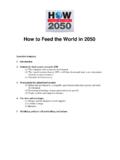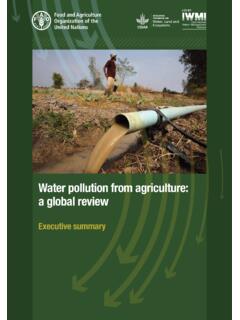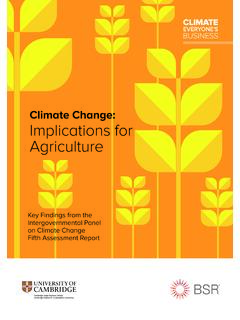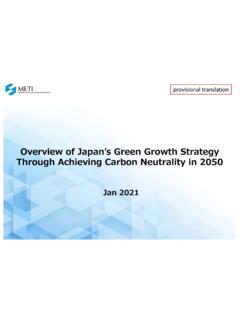Transcription of Water and Agriculture in India - OAV
1 Water and Agriculture in India Background paper for the South Asia expert panel during the global Forum for Food and Agriculture (GFFA) 2017.. Dr. Vibha Dhawan Content Chapter Content Page number 1 Introduction 3. 2 India 's Agriculture sector 4. Droughts and their impact 5. 3 Water available for agricultural production 7. Available Water 7. Water availability in different regions of India 8. 4 Water and Agriculture 9. Groundwater and surface Water use for Agriculture 9. Groundwater utilization for irrigation 9. Irrigation in India 12. Intensity of irrigation 12. Groundwater-based irrigation 13. Programs supporting irrigation 15. Water use efficiency in Agriculture 16. Virtual Water flow 18. Programs and technologies related to Water use efficiency 19. Institutional and policy aspects 19. Watershed development for Water use efficiency in the Agriculture sector 21. Water rights and Water pricing 24. 5 Conclusions 25. 6 Possible options for action 25. 2. Water and Agriculture in India Status, Challenges and Possible Options for Action.
2 1. Introduction Water is a critical input into Agriculture in nearly all its aspects having a determining effect on the eventual yield. Good seeds and fertilizers fail to achieve their full potential if plants are not optimally watered. Adequate availability of Water is important for animal husbandry as well. Fisheries are, of course, directly dependent on Water resources. India accounts for about 17%. of the world's population but only 4% of the world fresh Water resources. Distribution of these Water resources across the vast expanse of the country is also uneven. The increasing demands on Water resources by India 's burgeoning population and diminishing quality of existing Water resources because of pollution and the additional requirements of serving India 's spiraling industrial and agricultural growth have led to a situation where the consumption of Water is rapidly increasing while the supply of fresh Water remains more or less constant. Surveys conducted by the Tata Institute of Social Sciences (TISS) showed most of urban cities are Water deficient.
3 Nearly 40% of Water demand in urban India is met by ground Water . As a result ground Water tables in most cities are falling at alarming rate of 2-3 meters per Water scarcity has many negative impacts on the environment, including lakes, rivers, wetlands, and other fresh Water resources. Additionally, Water overuse can cause Water shortage, often occurs in areas of irrigation Agriculture , and harms the environment in several ways including increased salinity, nutrient pollution, and the degradation and loss of flood plains and wetlands. Furthermore, Water shortage makes flow management in the rehabilitation of urban streams problematic. Owing to poor Water resource management system and climate change India faces a persistent Water shortage. As per OECD environmental outlook 2050, India would face severe Water constrains by 2050. Indian Agriculture accounts for 90% Water use due to fast track ground Water depletion and poor irrigation systems. 1 3. Another cause of concern is Water quality.
4 The eventual pressure for efficient use of highly scarce Water resources thus rises manifold. This paper reviews the current status of Water availability in India ; its usage in Agriculture ; Water smart technologies developed in Agriculture and how India is attempting to move towards sustainability. 2. India 's Agriculture Sector India ranks 2nd world wide in farm output. Agriculture and allied sectors like forestry and fisheries accounted of the GDP (Gross Domestic Production) in 2013, and employed 50%. of the workforce. The irrigation infrastructure includes a network of canals from rivers, ground Water , well based systems, tanks and other rain Water harvesting products for Agriculture activities. Today ground system is the largest, covering 160 million ha of cultivated land in India with 39 million ha irrigated by ground Water , 22 million ha by irrigated canals and about two third of cultivation in India is still depending on monsoon. The earth, the land and the Water are not an inheritance from our forefathers but on loan from our children.
5 So, we have to handover to them at least as it was handed over to us.. - Mahatama Gandhi2. India is the world's largest producer of fresh fruits and vegetables, milk, major spices, various crops such as jute, staples such as millets and castor oil seed. It is also the second largest producer of wheat and rice. The average size of the around 138 million farms was around ha in 2010/11 and average size of large-scale farmers' farms ( ) is around 37 ha in 2016. (BMEL India country report 2016). Agricultural extension has only one extension worker per 800-1000 farmers and degree of mechanization reaches less than 50% (BMEL India country report 2016). Indicators of Water stress and scarcity are generally used to reflect the overall Water availability in a country or a region. As per the international norms, a country is classified as Water stressed and Water scarce if per capita Water availability goes below 1700 m3 and 1000. 2 Newman, J. (2011). Green Ethics and Philosophy: An A-to-Z Guide (Vol.)
6 8). Sage. 4. m3, respectively. With 1544 m3 per capita Water availability, India is already a Water -stressed country and is moving towards turning into Water scarce. Droughts and their impact Droughts have severe impacts on economy, society and environment affecting crops, irrigation, livestock, wildlife, soil, health problems, public safety ultimately leading to severe loss to human life. Drought in India has resulted in millions of deaths over the course of the 18 th, 19th, and 20th centuries. The latest findings suggest that while there have been alternate dry and wet spells over the past three decades, the frequency of occurrence of drought years has significantly increased in India . The period between 1950 and 1989 had 10 drought years, while there have been 5 droughts in the last 16 years (since 2000). According to meteorologists the frequency is set to increase between 2020 and Indian Agriculture is crucially dependent on the local climate: favorable southwest summer monsoon is critical in securing Water for irrigating crops.
7 In some parts of India , the lack of monsoons result in Water shortages, resulting in below-average crop yields. This particularly occurs in major drought-prone regions such as Southern and Eastern Maharashtra (Western India ), Northern Karnataka (South-Western India ), Andhra Pradesh (Southeastern coast of India ), Odisha (Eastern coast of India ), Telangana (Southeastern coast of India ) and Rajasthan (Western India ) [Figure 1].4. Droughts mean less Water availability for Agriculture than usual. Increased groundwater use during droughts can help overcome such critical periods. However, the resulting groundwater overuse and quality deterioration mean there is also less groundwater available for Agriculture than there was before, thereby causing even more pressure on agricultural production. The key point of consideration is that all the above mentioned impacts must be critically considered during planning and responding to drought conditions. 3 Collison, A., Wade, S., Griffiths, J.
8 , & Dehn, M. (2000). Modelling the impact of predicted climate change on landslide frequency and magnitude in SE England. Engineering Geology, 55(3), 205-218. 4 5. Figure 1. India has about 140 million ha of cultivable land (BMEL, India country report, 2016). 42% of the country's cultivable land lies in drought-prone areas/districts. Moreover, 54% of India 's net sown areas dependent on rain, rain fed Agriculture plays an important role in the country's economy. An achievement of food security, at the current nutritional levels, requires an additional 100 million tons (MT) of food grain to be produced or imported by 2020. Realistically, the total contribution of irrigation Agriculture to food grain production from both area expansion and yield improvement would contribute a maximum of 64 MT by 2020. The remaining 36 MT is contributed from the rain fed or drought-prone areas and from of imports. According to estimates, 40% of the additional supply of food grain requirement as to meet the 6.
9 Rice demand has to come from these areas. Poor agricultural productivity was observed during 2015 and early months of 2016, however in the summer of 2016 precipitation reached usual or higher levels than average, thereby 2016/2017 is expected to bring good results. Earlier food shortages were mainly due to the shortage in food grains and not Water but, today ground Water depletion is serious cause of concern. For example, in Sonwati village in Latur district of Maharashtra (Western India ), groundwater was available within six meters, but now even 244. meter deep bore wells have gone dry. This has lead to a situation where there is no Water , no fodder and decline in farm produce, says the farmer. A long-term strategy to make India drought-free is the substantial message for overcoming 2016 crisis though there is a positive hope for 2017. 3. Water available for Agricultural Production Available Water India is not a Water rich country and is further challenged due to negative impact of climate change; enormous wastage owing partly to poor management and distorted Water pricing policies.
10 The Northern Ganga River Basin has abundant Water resources, whereas the Southern River Basin has few, but with high levels of pollution in ground Water and surface Water . Increase in population and changing lifestyles has increased demand for Water (largely for irrigation) in both urban and rural areas. India has 18% of world population, having 4% of world's fresh Water , out of which 80% is used in Agriculture . India receives an average of 4,000. billion cubic meters of precipitation every year. However, only 48% of it is used in India 's surface and groundwater bodies. A dearth of storage procedure, lack of adequate infrastructure, inappropriate Water management has created a situation where only 18-20% of the Water is actually used. India 's annual rainfall is around 1183 mm, out of which 75% is received in a short span of four months during monsoon (July to September). This result in run offs during monsoon and calls for irrigation investments for rest of the year. The population of India is likely to be billion by 2050, resulting in increased demand for Water , food and energy.







